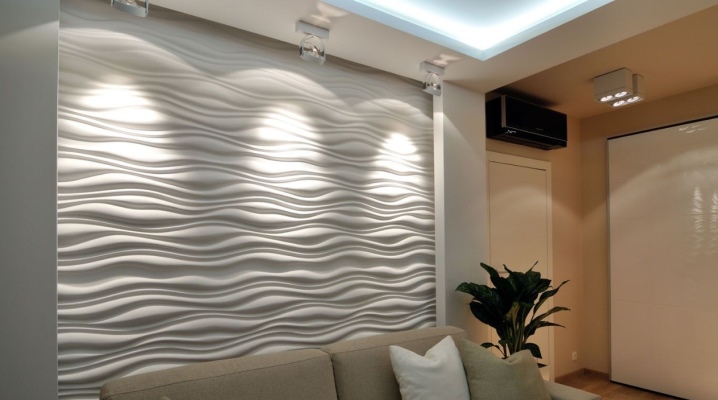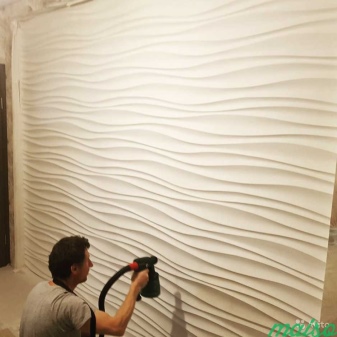Subtleties of installation of 3D gypsum panels

Volumetric gypsum plasterboard panels are a popular material, through which you can create amazing interior wall decoration in any residential and office space. Due to the varied texture of the gypsum boards, a different effect is achieved that is acceptable for the chosen interior style. Knowing the requirements for installation, everyone can independently create an exquisite atmosphere of their home with the help of 3D panels.

Advantages and disadvantages
Gypsum material has its own advantages and disadvantages, which you need to know about when planning to install panels in your apartment or house. Advantages of decorative finishes:
- combination with other materials;
- the possibility of additional processing by varnishing and staining;
- good thermal insulation characteristics of products;
- high sound insulation performance;
- low flammability and extreme resistance to damage when exposed to high temperatures;
- solidity, the integrity of the connection of the panels, the seams are invisible to the eye with proper installation;
- health safety - no harmful emissions and irritating odors;
- increased level of moisture resistance;
- immunity to mechanical stress and damage;
- long service life (not less than 50 years);
- ease of maintenance - dust from the panels can be swept away once a week, it does not accumulate on the material.


It is also worth mentioning such advantages of plasterboard wall decoration as a huge number of design options and the ability to independently change their color and even texture.

But gypsum wall products also have their disadvantages:
- The biggest drawback is its impressive weight: even small 50X50 panels weigh about 10 kg, and, of course, this makes them difficult to install. This fact has to be taken into account and only strong external and internal walls should be chosen for cladding.
- When buying panels made without observing the technology, significant defects may occur: surface damage, mismatch of the ornament, even dangerous fumes if unknown components are included in the composition.
- Problems with the appearance of drywall also arise as a result of improper installation, and then gaps are visible between the plates, the overall pattern may be disturbed. It is necessary to lay the panels with knowledge of the matter, and before that, carry out a thorough processing of the base.

What is required?
To complete the installation of bulk products, the following tools and related materials must be available:
- special plaster saw with large teeth (file, power tool);
- 3 spatulas - normal, 10 mm notched, narrow rubber;
- 2 drills adapted to the size of screws and plugs;
- fine-grained abrasive cloth;
- glue designed for drywall;
- roller and brush for the primer mixture;
- plumb line / building level (laser, normal);
- impact mechanism for perforation;
- drill screwdriver;
- cork and plastic screws;
- primer and filler mortar for sealing joints between panels.



The fact that no complicated equipment is required for work is a certain advantage of installing 3D panels, and the listed tools are found in almost every home.
How to fix it?
If you are going to install volumetric drywall panels with your own hands, you need to adhere to the exact algorithm of work and follow the rules of the technological process. Installation of embossed gypsum slabs is carried out in 2 versions. It is allowed to fasten the panels with dowels - it is much easier and more durable, but the general appearance of the walls may suffer. The seamless method involves planting the slabs on glue, which ensures the solidity of the resulting canvas.


A step-by-step guide will help you with your work.
- First of all, you need to prepare everything you need, including a sufficient number of 3D gypsum panels of the required thickness, format and texture, taking into account the use of skirting boards - in this situation you will have to cut the material.

- This is followed by a thorough marking - if there is no skill in laying, experts recommend first marking the surface of the walls, and spreading the panels on the floor, determining their correct position. You will need the help of the electronic level.

- Plasterboard is laid in almost the same way as ceramic tiles, so you will need to install base stops, which will become the basis for installing gypsum sheets. For this, a metal reinforcement bar or a regular timber bar is used, which is attached to the walls with screws on the line of the second row of panels.

They begin to mount the sheets from the second row, and the lower panels - at the very end, so as not to damage them.
Now, in more detail about the process itself using glue or an alternative option - liquid nails:
- volumetric panels are laid on an already processed dry flat surface, primed in advance, but you can also glue the material on the wallpaper;
- the glue is applied with a spatula and evenly distributed over the area where the boards will be installed;
- a sheet of drywall must be attached to the wall, pressed and brought into position according to the markings, this is done from the left edge;
- the entire second row and subsequent ones are installed in the same way, and the excess glue is removed immediately, it will be difficult to get rid of it in the hardened form, you can damage the panels;
- if necessary, trimming the sheets is done with a hacksaw or a fine saw, the cut is sanded with fine-grained emery;
- it is possible to grind the seams with a seamless method at the end of the installation with a rubber trowel and plaster putty.

A simplified method is to fit the slabs onto dowels (Molly, Driva). To do this, you need to drill holes in drywall, make a chamfer up to 3 mm deep and 2 mm larger than the size of the fastener collar. For walls made of bricks and concrete, galvanized dowel-nails are used. At the same time, gypsum-based glue is also applied to the area for installing the panels. The joints are filled with putty, and after drying, its excess is also removed with sandpaper.
How to paint?
Upon completion of the installation, painting is carried out, the purpose of which is not only to give the products a pleasant appearance, but also to protect them from external influences. Any decorative paint with good performance can be used as a coating.

Steps to be taken:
- before covering the surface of the slabs with the desired composition, for optimal adhesion, a primer with antiseptic inclusions is applied to them;
- you can paint the finished walls with a paint roller for panels with a minimum relief; when drawing with very prominent details, it is better to use a spray gun;
- smooth, gradual transitions are achieved with a sponge, with which the solution is rubbed into the surface.


For drywall, it is better to take special panel compositions that are highly resistant, durable and strong.
Basically, different types of dyes are suitable for coloring: latex, textured, water-based. For the information of those who decided to use this wonderful material: you can repaint the panels without losing their appearance and quality indicators more than 20 times.

Beautiful examples
In interior design, volumetric gypsum panels are mounted both on the walls and on the ceiling, but it is important not to be mistaken with the texture, color and compliance with the style direction.
- For a living room in a minimalist style, you can choose an unusual texture and color of volumetric slabs.

- The use of this material allows you to create an extraordinary futuristic design, but the installation of complex, including wavy ornaments, requires the help of a professional.

- 3D panels in light pastel colors will make a small bedroom more spacious and airy. In addition, the material can be perfectly combined with smooth surfaces.

- Plasterboard with different textures in the form of a separate panel can decorate the kitchen and dining room.

When choosing three-dimensional images for your walls, you should know that transverse ornaments visually expand the space of the room, while vertical designs give the effect of height and visually raise the ceilings.











The comment was sent successfully.